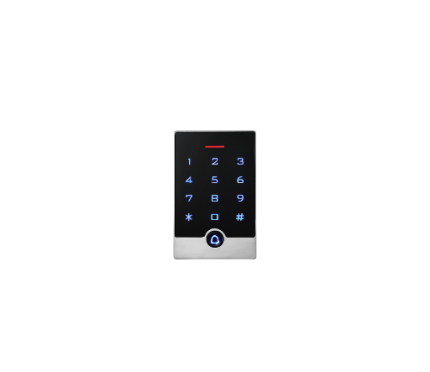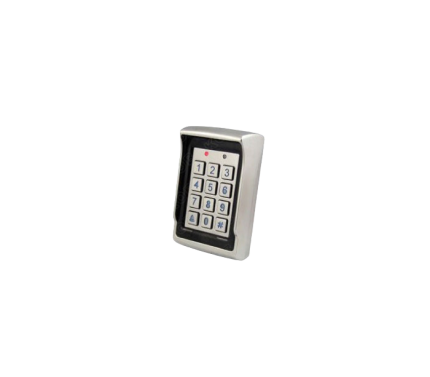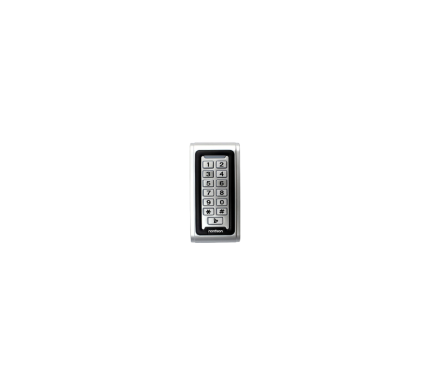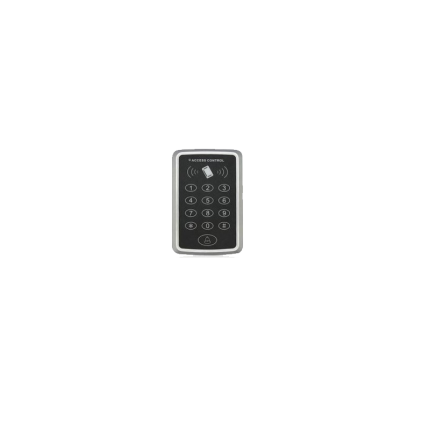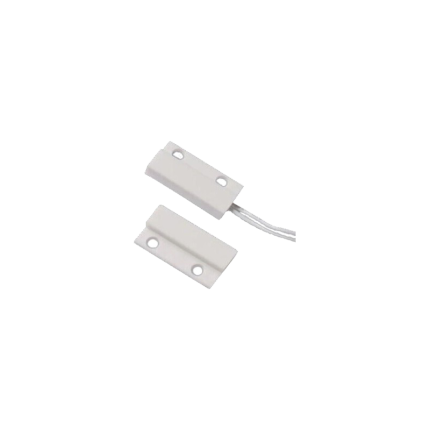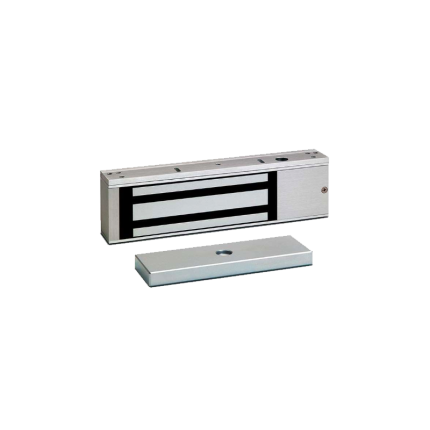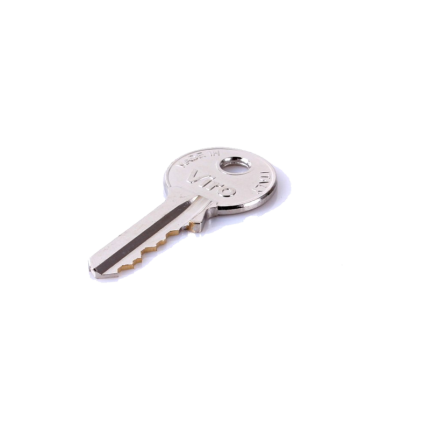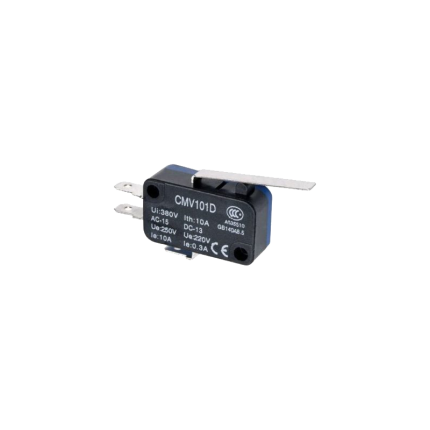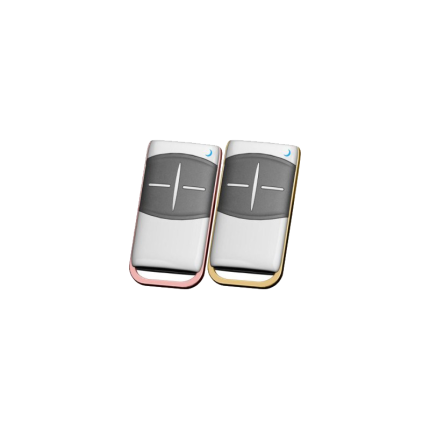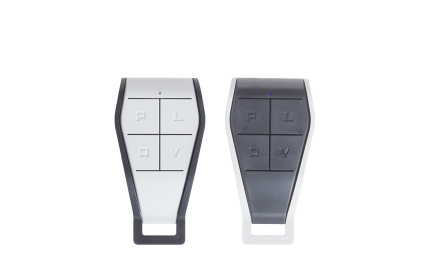Shop
Keypad Access Control K155ST15
Ship or pick up from our office.
Keypad Access Control K155ST15
*Rain Shield Cover included *EM/ID card/tag reader *Finger Touch *Backlight *2000 Users *DC 12 V *IP 67 (Waterproof) *Doorbell button This unit is a standalone access controller or a Wiegand output keypad/card reader suitable for mounting indoors or outdoors, even in harsh environments. It features a sturdy, vandal proof Zinc Alloy electroplated case available in bright silver or matte silver finishes. The electronics are fully potted, ensuring durability. With support for up to 2000 users in Card, PIN, or Card + PIN configurations, this unit is ideal for small shops, domestic households, as well as commercial and industrial applications such as factories, warehouses, laboratories, banks, and prisons.Key Features
- Waterproof: IP68 rated for outdoor use
- Material: Strong Zinc Alloy Electroplated anti vandal case
- User Capacity: 2000 users, supports Card, PIN, Card + PIN
- Adjustable Timers: Door output time, Alarm time, Door Open time
- Short Circuit Protection: Lock output current short circuit protection
- Built in Features: Light dependent resistor (LDR) for anti tamper, built in buzzer
- LED Status Indicators: Red, Yellow, and Green LEDs display the working status
Technical Specifications
- Operating Voltage: DC 12V ±10%
- User Capacity: 2000
- Card Reading Distance: 3 6 cm
- Active Current: < 60mA
- Idle Current: 25 ± 5mA
- Lock Output Load: Max 3A
- Alarm Output Load: Max 20A
- Operating Temperature: 45 60
- Operating Humidity: 10% 90% RH
- Adjustable Door Relay Time: 0 99 seconds
- Adjustable Alarm Time: 0 3 minutes
- Wiegand Interface: Wiegand 26 bit
- Size: 120 x 76 x 23mm
- Wiring Connections: Electric Lock, Exit Button, External Alarm, External Reader
Keypad Access Control K170S300A
Keypad Access Control K170S300A
*Rain Shield Cover Included *Waterproof Version *EM/ID card/tag reader *Backlight *DC 12 V *Shock resistance *Anti-vandal Metal shell *Doorbell Button Wiegand Output: Equipped with a Wiegand output for seamless integration with a controller. Multiple Access Modes: Offers Card, PIN, or Card + PIN options, providing versatile access control methods. Durable Metal Case: Housed in a robust Zinc Alloy electroplated case, ensuring durability and vandal resistance. RFID Key Fob Duplicator Attribute-Based Access Control Vs Role-Based Access Control 1,000 User Capacity: Supports up to 1,000 users, ideal for large-scale access control in commercial and industrial settings. Backlight Keypad: Features a backlight keypad for easy operation in low-light conditions.Description
1000 Users Metal Case 125KHZ RFID Card Keypad Access Controller with Backlight Door Control Independent Code Access Device
Description
Single door multifunction standalone access controller or a Wiegand output keypad or card reader.
It is suitable for mounting either indoor or outdoor in harsh environments.
It is housed in a strong, sturdy and vandal proof Zinc Alloy electroplated case which is availabl in either a bright silver or matt silver finish.
Metal Case&Waterproof .Supports up to 1000 users in either a Card, 4 digit PIN, or a Card + PIN option.
The inbuilt card reader supports125KHZ EM cardsLock output current short circuit protection, Wiegand output , and a backlight keypad.
Ideal choice for door access not only for small shops and domestic households but als for commercial and industrial applications such as factories, warehouses, laboratories, banks and prisons.
Features
Simple Programming, Easy Operatio
Adopt function steady card reader of block
Keypad Locks for 30 Seconds After 10 False Entrie
Can be Connected with Door-open Button and Doorbel
Non-volatile Memory in Power Failure
Tamper Switch can be Connected to Security Alarm System
Backlight key
Wiegand 26 output for connection to a controller
Support 1000Users
Keypad Access Control K280S6
Keypad Access Control K280S6
*Rain Shield Cover included *Backlight *DC 12-24 V *EM/ID card/tag reader *2000 Users *Doorbell *Shock resistance *Anti-vandal Metal shell *IP67Keypad access control is a security system that uses a keypad to restrict entry to authorized individuals by requiring them to enter a specific code.
Instead of physical keys, users input a PIN or code on the keypad, and if the code is correct, the system unlocks the door or gate.
Here's a more detailed explanation:
How it works:
-
Keypad:A keypad, typically with numbered buttons, is installed at the entry point.
-
Code Entry:Users enter a pre-defined code on the keypad.
-
Access Granted:If the code matches the system's records, the door or gate is unlocked, granting access.
-
Security:Keypad access control systems offer a higher level of security than traditional locks and keys, as codes can be changed and managed more easily.
-
Convenience:They provide keyless entry, eliminating the need to carry physical keys or fobs.
-
Integration:Keypad systems can be integrated with other security systems, such as access control panels or alarm systems.
Types of Keypad Access Control:
-
Standalone:These systems are self-contained and don't require external software or computers.
-
Networked:These systems are connected to a network, allowing for centralized management and reporting.
-
Integrated:Keypads can be part of a larger access control system, often combined with other methods like RFID cards or biometrics.
Common Applications:
-
Residential Buildings:Keypads can be used for entry into apartment buildings, condos, or individual units.
-
Commercial Buildings:Keypads are used for access control in offices, retail stores, and other businesses.
-
Industrial Facilities:Keypads can control access to restricted areas in factories and warehouses.
-
Gates and Barriers:Keypads can be used to control access to parking lots, garages, or other gated areas.
Benefits of Keypad Access Control:
-
Enhanced Security:Keypads provide a secure way to manage access, reducing the risk of unauthorized entry.
-
Increased Convenience:Keyless entry eliminates the hassle of carrying keys.
-
Scalability:Keypad systems can be easily scaled to accommodate changes in access requirements.
-
Cost-Effectiveness:Keypad systems can be a cost-effective solution for access control, especially when compared to more complex systems.
Keypad KO05SC107
Ship or pick up from our office.
Keypad KO05SC107
*Waterproof Keypad Version *EM/ID card/tag reader *Backlight Keypad *1000 Users *DC 12 V *Rain Shield Cover included in the keypad packageMagnetic Contact Switch – Wired
Ship or pick up from our office.
Magnetic Contact Switch
A magnetic contact switch, often simply called a magnetic contact or door/window sensor, is a simple yet highly effective security device that detects when a door, window, gate, or any movable barrier is opened or closed. How it Works: It consists of two main parts:- The Sensor Unit (with a Reed Switch): This part contains a reed switch. A reed switch is a small, hermetically sealed (airtight) glass capsule with two tiny, flexible magnetic metal reeds (or contacts) inside. These reeds are usually made of a ferromagnetic material. This sensor unit is typically mounted on the stationary part of the opening (e.g., the door frame, window frame, or gate post).
- The Magnet Unit: This part contains a small, permanent magnet. This unit is mounted on the moving part of the opening (e.g., the door itself, the window sash, or the gate panel).
- Closed Position (Circuit Complete): When the door/window/gate is closed, the magnet unit is in very close proximity to the sensor unit. The magnetic field from the permanent magnet pulls the two tiny reeds inside the glass capsule together, causing them to make electrical contact. This completes an electrical circuit, indicating that the opening is secured.
- Many common contacts are "Normally Open" (NO), meaning the circuit is open when the magnet is away and closes when the magnet is near.
- Some are "Normally Closed" (NC), meaning the circuit is closed when the magnet is near and opens when the magnet is away. This is very common in security systems, as an "open" circuit triggers an alarm.
- Opened Position (Circuit Broken/Changed): When the door/window/gate is opened, the magnet moves away from the reed switch. As the magnetic field weakens, the reeds spring back to their original position, breaking the electrical contact. This change in the circuit (from closed to open, or open to closed, depending on the type) signals the connected system (e.g., a car alarm, home security system, or gate control panel) that the opening has occurred.
- Security Systems (Homes, Businesses, Vehicles): This is the most prevalent use. Magnetic contacts are placed on:
- Doors and Windows: To detect unauthorized entry. When a door or window is opened, it triggers the alarm.
- Garage Doors/Overhead Doors: Larger, more robust magnetic contacts are used for garage doors.
- Gates: Used on pedestrian gates or even main driveway gates (sometimes in conjunction with the gate opener's own limit switches) to monitor their open/closed status for security purposes.
- Safes and Vaults: To detect if they have been opened.
- Vehicle Doors/Trunks/Hoods: While vehicles have internal sensors, magnetic contacts can be added for enhanced security on specific compartments or custom modifications.
- Access Control Systems: To monitor entry and exit points, log access events, or control other devices based on door status.
- Automation Systems: To trigger actions based on the status of a movable part. Examples include:
- Turning lights on/off when a door opens.
- Indicating when a cabinet door is ajar.
- Position sensing in industrial machinery.
- Appliance Safety: Some appliances use magnetic contacts to ensure a lid is closed or a guard is in place before operation.
- Surface Mount: Most common, easily screwed or adhered to the surface of the frame and door.
- Recessed/Flush Mount: Designed to be drilled into the frame and door for a more discreet, hidden installation.
- Heavy Duty/Overhead Door Contacts: Larger and more rugged, built for the heavier use and larger gaps often found with garage or industrial doors.
- Wired vs. Wireless:
- Wired: Physically connected to the alarm panel via wires, offering high reliability.
- Wireless: Contain a small battery and a radio transmitter to send signals wirelessly to the alarm panel, offering easier installation.
Magnetic lock
Ship or pick up from our office.
Magnetic lock
*Capacity: 180 Kg *DC 12 VManual release key – Swing/Sliding gate openers
Ship or pick up from our office.
Manual release key – Swing/Sliding gate openers
All types of sliding gate openers and swing gate operators have a manual release key to get the driveway gate operator into the manual mode. The manual release key shape and type are different, and depend on the brand and model of the driveway gate opener. To release a swing gate opener or sliding gate operator in emergency times when the driveway gate is closed, the gate operator is not working, and not opening the gate for any reason, the resident needs to open the gate using the release key.Manual release key – Swing/Sliding gate openers
Ship or pick up from our office.
Manual release key – Swing/Sliding gate openers
A swing or sliding gate opener release key is a tool that allows you to manually operate a swing gate when the automatic opener is not functioning, such as during a power outage. It disengages the automatic mechanism, enabling the gate to be opened or closed manually.
Here's a more detailed explanation:
-
Purpose:The key is used to unlock the gate opener's motor, allowing it to be moved by hand.
-
Location:The release mechanism is often found near the gate motor, either on the motor itself or in a nearby housing.
-
Functionality:The key may turn a dial or lever that releases the motor's gears, enabling manual operation.
-
Importance:This manual release mechanism is essential for emergency access and situations where the automatic system is unavailable.
Mercury Level Switch
Ship or pick up from our office.
Mercury Level Switch
A mercury level switch is a type of electrical switch that uses a small amount of liquid mercury to open or close an electrical circuit based on its position or the level of a liquid. Essentially, the mercury acts as a conductive bridge between electrical contacts. How it Works The core component of a mercury level switch is a sealed glass or metal capsule containing one or more electrical contacts and a small, free-moving drop of mercury. When the switch or the liquid it's monitoring changes its tilt or level:- Tilt Switches: Gravity pulls the mercury to the lowest point within the capsule. If the tilt is sufficient, the mercury will flow to connect two or more contacts, completing an electrical circuit. Tilting it in the opposite direction moves the mercury away, breaking the circuit.
- Float Switches: In liquid level applications, the mercury switch is often integrated with a float mechanism. As the liquid level rises or falls, the float moves, which in turn tilts the mercury switch, causing the mercury to connect or disconnect the contacts.
- Displacement Switches: Some designs use a "plunger" that dips into a pool of mercury, raising the mercury level to contact an electrode and complete the circuit.
- Thermostats: In older thermostats, they controlled heating and cooling systems.
- Sump Pumps: Used to automatically turn on the pump when water levels rise.
- Appliances: Found in washing machines (for lid switches and load balancing), chest freezers (for lid lights), and some gas appliances like ovens and water heaters (as flame sensors).
- Automotive Industry: Previously used for trunk lid lights, ride control, and anti-lock braking systems.
- Industrial Settings: Utilized in liquid level control and safety systems.
- Roll Sensing/Tip-over Warnings: For construction equipment or other vehicles operating on uneven terrain.
- Durability and Reliability: The sealed contacts prevent oxidation, leading to a long lifespan.
- Quiet Operation: No abrupt snapping of contacts.
- No Contact Erosion: Mercury's liquid nature prevents the wear and tear seen in mechanical contacts.
- Spark-Free: They don't produce sparks when making or breaking circuits, making them suitable for hazardous environments.
- Toxicity of Mercury: This is the primary and most significant disadvantage. Mercury is a highly toxic substance, posing serious environmental and health risks if released.
- Environmental Concerns: Improper disposal of mercury switches can lead to widespread contamination. Due to these concerns, the use of mercury switches has been largely phased out in many applications, especially in new products.
- Sensitivity to Gravity/Orientation: While an advantage for tilt sensing, it makes them unsuitable for portable or mobile devices where orientation changes or vibrations could cause false readings.
- Limited Functionality: Most mercury switches provide only a simple on/off function.
Metal Case Diode Bridge KBPC5010
Ship or pick up from our office.
Metal Case Diode Bridge KBPC5010
The Metal Case Diode Bridge KBPC5010 is a specific type of bridge rectifier, a crucial electronic component used to convert alternating current (AC) into direct current (DC). It is widely employed in various power supply applications. Here's a breakdown of its key features and what each part of its name signifies: What is a Bridge Rectifier? A bridge rectifier is a circuit of four (or more) diodes in a specific configuration that allows for full-wave rectification. This means it efficiently converts both the positive and negative half-cycles of an AC input into a pulsating DC output. Compared to simpler half-wave rectifiers, bridge rectifiers are more efficient and provide a smoother DC output. KBPC5010 Explained- KBPC: This is typically a series designation for a family of single-phase bridge rectifiers with specific package styles.
- 50: This number indicates the maximum average forward rectified current (Io) the device can handle, which in this case is 50 Amperes (A). This high current rating makes it suitable for demanding applications.
- 10: This number typically refers to the voltage class, often indicating a maximum repetitive peak reverse voltage (VRRM) of 1000 Volts (V) (where '10' often means 10 x 100V). This high voltage rating allows it to handle substantial AC input voltages.
- Conversion: Converts single-phase AC to pulsating DC.
- Current Rating: Up to 50 Amperes (A) average forward current.
- Voltage Rating: Up to 1000 Volts (V) repetitive peak reverse voltage.
- Surge Current Capability: Often capable of handling high non-repetitive surge currents (e.g., 400A or 450A for a short duration), which is crucial for handling initial power-on transients.
- Low Forward Voltage Drop: Minimizes power loss and improves efficiency.
- High Reliability: Designed for robust performance in various environments.
- Mounting: Typically features through-hole mounting with a screw hole for chassis or heatsink mounting.
- Terminals: Often uses 0.25" (6.35 mm) Faston terminals for easy connection. Some variants (like KBPC5010W) might have wire leads.
- Operating Temperature: Wide operating junction temperature range, often from -40°C to +150°C.
- Power supplies: As a core component to rectify AC mains voltage into DC for electronic devices.
- Battery chargers: Converting AC power to DC for charging batteries.
- Motor control circuits: Providing DC power for electric motors.
- Industrial control systems: Used in various industrial applications requiring AC-to-DC conversion.
- Input rectifiers for variable frequency drives (VFDs).
Micro Limit Switch
Ship or pick up from our office.
Micro Limit Switch
A micro limit switch, often simply called a micro switch, is a type of electrical switch that's characterized by its small size and the precise, rapid action it takes when a minimal amount of force is applied to its actuator. It's designed to detect the presence or position of an object or the end of a mechanical movement. These switches are known for their:- High sensitivity: They require very little force to activate.
- Rapid response: The internal contacts "snap" open or closed very quickly, regardless of how slowly the actuator is pressed. This snap-action mechanism helps to reduce arcing and extends the switch's lifespan.
- Reliability: They are built to withstand millions of operations, making them durable for long-term use.
- Compact size: Their small footprint allows them to be used in applications where space is limited.
- Actuator: This is the external part that an object or mechanical component presses against. It can be a button, a lever (with or without a roller), a plunger, or other forms.
- Internal spring mechanism: This provides the "snap-action." When the actuator is pressed to a certain point (the "trip point"), the spring mechanism rapidly moves the contacts.
- Contacts: These are the electrical components that open or close the circuit. Micro switches usually have three terminals:
- Common (C): The input terminal.
- Normally Open (NO): This contact is open (no current flows) when the switch is unactivated and closes when the switch is actuated.
- Normally Closed (NC): This contact is closed (current flows) when the switch is unactivated and opens when the switch is actuated
- Household Appliances:
- Microwave ovens: To detect if the door is closed before operating.
- Washing machines: For door interlocks and water level detection.
- Refrigerators: To turn the light on/off when the door opens/closes.
- Printers: To detect paper jams or the position of paper.
- Automotive Industry:
- Car doors: To detect if a door is open or closed (e.g., for interior lights or security systems).
- Brake pedals: To activate brake lights.
- Seat belt mechanisms: To detect if a seat belt is fastened.
- Industrial Automation:
- Conveyor systems: To detect the presence of items or the end of travel for a belt.
- Robotic arms: For precise positioning and limit detection of movement.
- Machine safety guards: To ensure guards are correctly positioned before machinery operates.
- Elevators and hoists: To prevent over-travel and ensure proper door operation.
- Consumer Electronics:
- Computer mice and keyboards: For button clicks.
- Vending machines: For coin detection or jam detection.
- Medical Equipment:
- In various diagnostic tools and surgical instruments for precise control.
- Pin Plunger: A simple button-like plunger that is directly pressed.
- Roller Lever: Features a lever with a roller at the end, ideal for applications with sliding or rotating components.
- Hinge Lever: A simple lever arm that pivots to actuate the switch.
- Flexible Roller: Similar to a roller lever, but with a more flexible arm to accommodate irregular surfaces or wider ranges of motion.
- Spring Plunger: A plunger supported by a spring, allowing for a certain degree of "overtravel" beyond the actuation point without damaging the switch.
Original Gate Opener Remote Control
Ship or pick up from our office.
Original Gate Opener Remote Control
*433 MHz *2-4 Buttons *(More than 10 different designs)A gate opener remote is a handheld device that allows you to remotely open and close an automatic gate.
It sends a radio signal to a receiver connected to the gate's motor, triggering the gate to move. These remotes are a convenient way to control access to properties, especially when entering or exiting with a vehicle.
Here's a more detailed explanation:
-
Function:The remote transmits a radio signal to a receiver unit connected to the gate opener motor.
-
Convenience:They eliminate the need to manually open or close the gate, providing convenience and security.
-
Compatibility:Remotes must be compatible with the gate opener's frequency and coding system.
-
Types:There are various types of remotes, including single-button (for basic open/close) and multi-button (for more complex functions like stopping or partially opening the gate).
-
Programming:Remotes need to be programmed to work with the specific gate opener.
-
Frequency:Most gate openers use 433.92 MHz frequency, but some older systems might use different frequencies.
-
Range:The range of the remote can vary depending on obstructions like trees or buildings.

